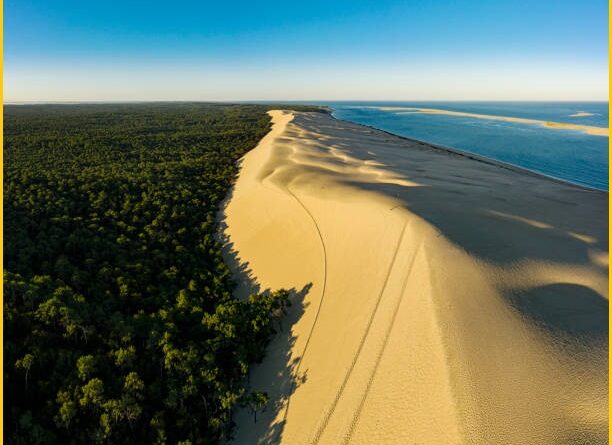The Magic of the Dunes of Pilat, A France’s Coastal Gem
Dunes of Pilat
The Dune of Pilat, also known as Grande Dune du Pilat, is the tallest in Europe. Situated in La Teste-de-Buch near the Arcachon Bay area in France, it lies approximately 60 km southwest of Bordeaux along the Atlantic coastline. The Dune of Pilat is a renowned tourist attraction with over two million visitors annually. Formed over 4,000 years ago on the site of ancient protohistoric camps, the Dune of Pilat now attracts nearly two million visitors annually, making it one of France’s most popular natural sites, second only to the Calanques of Cassis. Spanning almost three kilometers, its exposed location along the sea and steep slopes create ideal conditions for paragliding, drawing enthusiasts from around the world.
Since 1922, numerous archaeological discoveries have been made at the dune. In 2013, a tourist found a funeral urn and accessory vase from the Iron Age, dating back to approximately 800 BC, at its base. The Dune of Pilat has an estimated volume of around 60 million cubic meters, spanning approximately 500 meters in width from east to west and extending 2.7 kilometers in length from north to south, covering an area of 1.35 square kilometers. In 2018, its height was recorded at 106.60 meters above sea level.
The Dune of Pilat-History
As a foredune, it runs parallel to the shoreline just behind the beach’s high tide line. Over time, the dune has gradually moved landward, encroaching on the forest and covering structures, roads, and parts of the Atlantic Wall. Historical maps from 1708 and 1786 show areas named Pilat south and offshore of the dune’s current position, indicating this coastal shift. Until the 1930s, the current site was known as “Les Sabloneys,” or “The New Sands,” before it was renamed the Dune of Pilat by real estate developer Daniel Meller. The name Pilat derives from the Gascon word Pilhar, meaning heap or mound.

On January 24, 2009, a storm hit the Dune of Pilat, with peak winds reaching 175 km/h, causing damage to the dune. The area now occupied by the Dune of Pilat once hosted temporary protohistoric camps used for sea salt mining. Archaeological exploration began in 1922, and on December 31, 2013, a tourist discovered a funeral urn and an accessory vase dating back to the Iron Age (around 800 BC) in the sand at the base of the dune. In October 2014, a team of about ten amateur archaeologists conducted a two-week excavation to better understand the stratigraphy and environmental context of these findings.
Also Read- Eruptions and Mysteries of Old Faithful Geyser
Camping at the Dune
This area offers plenty of camping options, with golden sandy beaches and stunning blue waters close by—not to mention the iconic dune itself. Load up the car with all your seaside essentials and prepare for a relaxing coastal getaway. Pyla Camping provides a wide range of accommodations for your stay near the dune. Relax by the pool, enjoy the beach, and let the kids have fun at the children’s club.
How to Reach Dune of Pilat
By Car: From Bordeaux: Take the A63 and A660 highways toward Arcachon. The trip is around 60 km and takes approximately 1 hour. Follow signs for “Dune du Pilat” or “La Teste-de-Buch.” By Train: From Bordeaux: Take a TER (regional train) from Bordeaux Saint-Jean Station to Arcachon Station (about a 50-minute journey). From Arcachon, you can take a bus or taxi to reach the dune.
By Bus: From Arcachon: Take the Baïa Bus (Line 1) from Arcachon Station toward Plage de la Salie, which stops near the Dune of Pilat. In peak tourist seasons, shuttle services often run directly from Arcachon to the dune.



